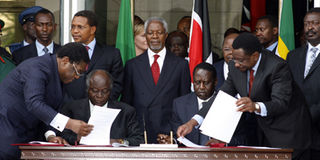Ladies and gentlemen, the ‘war’ to own Kenya’s history is on – enjoy!

The signing of the grand coalition agreement at Harambee House. When Kibaki came into office, had he implemented the MoU with Raila Odinga and made him prime minister, the wider constitution review process would have been put on the back burner. PHOTO: Fredrick Onyango
What you need to know:
- This is part of a not-so-subtle race to define the symbols of Kenya’s history, and to re-imagine the nation’s historical record.
- The Moi years come across as turbulent and painful — there are 1982 coup photos; and Raila Odinga, Koigi Wamwere, Gitobu Imanyara, Willy Mutunga, and all those activists of the 1980s and 1990s in handcuffs being led away by policemen.
- Not a week passes by without one of Kibaki's flagship projects, the Thika highway, being in the papers.
Two weeks ago, I passed through the Jomo Kenyatta International Airport. It was business as usual, including filling out the departure form. On Tuesday, I was back and the departure forms were history.
In this technology age where passports are scanned, mug shots and fingerprints taken at Immigration desks, the departure form was a ridiculous piece of anachronism. That said, it remains very popular, and Kenya joins South Africa among the few African countries to get rid of the silly thing.
But the most far-reaching change that has taken place at JKIA, is the easiest to miss — the images. A series of striking black and white photos have gone up on the walls in the departure lounge, telling the story of the laying of the foundation of the modern JKIA, and its construction.
The first photo is of Kenya’s founding President Jomo Kenyatta, and father of President Uhuru Kenyatta, laying the foundation stone. It is a historical fact that JKIA was Mzee Kenyatta’s project, so to speak, although it was named in his honour after he died.
My sense is that this is part of a not-so-subtle race to define the symbols of Kenya’s history, and to re-imagine the nation’s historical record that started after Mwai Kibaki came to power at the end of 2002, and has become pronounced this year because it is the 50th independence anniversary year.
To appreciate it, one needs to look at most photographs that newspapers use in their weekly 50th anniversary supplements.
The Moi years come across as turbulent and painful — there are 1982 coup photos; and Raila Odinga, Koigi Wamwere, Gitobu Imanyara, Willy Mutunga, and all those activists of the 1980s and 1990s in handcuffs being led away by policemen.
Mzee Kenyatta’s most famous is of him at the flag-raising on Independence Day. But there are many of him in the hectic post-independence building boom period opening all sorts of things, and hanging out with famous African and world leaders.
However, former President Kibaki takes the crown.
Not a week passes by without one of his flagship projects, the Thika highway, being in the papers. Kibaki did it all; he launched Lapsset, presided at listings on the Nairobi Stock Exchange more times than any other president will probably ever do, launched the expansion of the JKIA, and broke the ground for the Konza techno-city.
But he also has to contend with images from the post-election violence of early 2008 following the controversy around his re-election. Even in that, however, he still managed to get one of the most iconic photos of Kenya’s history — of him and Raila signing the pact for the formation of the Grand Coalition.
To prove that Kibaki was astute at this politics of image, he reached over Moi and Kenyatta, and appropriated the most world-famous personality of Kenyan liberation history, Mau Mau military chief Dedan Kimathi. He built a statue for him at the end of Kimathi Street, treading where neither Kenyatta nor Moi could.
It is hard to see what major thing young Kenyatta can do that Kibaki didn’t start, or whose strategic foundation was not set down in the rule of Kenya’s third president.
In that sense, the Mzee Kenyatta photos at JKIA are a masterstroke. The common view had always been that the airport was named after him posthumously as an honour. The photos have changed the context, and now it looks like it was named after him because he deserved it... he built it.
The other aspect of historical reconstruction, has been taking place in books. There has been a flurry of them by politicians and public figures over the last eight years.
Then along came former Prime Minister Raila’s The Flame of Freedom. Unlike all the other political books that confined themselves to no more than 10 years (except Njenga Karume’s) Raila’s was an attempt to recast about 60 years of Kenya’s history.
You can, therefore, expect that in keeping with this race to shape the Kenyan story, many of the next series of books will re-examine those 60 years.
It seems Kenyatta understands that these images are part of how Kenyan presidencies are made. If you love history, sit back and tighten your seat-belt. We have a race on our hands.
[email protected] & twitter: @cobbo3





